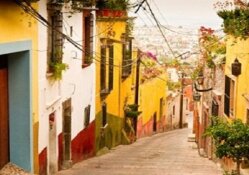[ad_1]
Many expats and retirees spend their days relaxing in coffee shops or catching up with friends on San Miguel de Allende’s main plaza. El Jardin. Artists work in studios throughout the city, and handicrafts, jewelry and other folk art are sold on the cobblestone streets. If you want to shop for creative goods, keep in mind that some stores close from 2 to 5 p.m. daily (except Sundays when many stores are closed all day).
While Spanish is the national language of Mexico, almost everyone in San Miguel speaks English. Most tours and services are offered in both languages, and you shouldn’t have too much trouble finding someone who speaks English if you need any help. If your Spanish could use some improvement, San Miguel de Allende is a good place to learn: language classes are a popular activity for visitors and new residents.
The moderate cost of living in San Miguel is one of its main draws. The Mexican peso (MXN), the national currency, is accepted throughout San Miguel. One peso is equal to approximately $0.075 USD. Visitors can exchange international currency at the Casa de Cambio (Currency Exchange Office). ATM machines will charge a service fee per transaction, but are likely to offer better exchange rates than local banks or exchange offices. You may not need much cash—most restaurants and shops in town accept major credit cards. Regardless of how you pay at a restaurant, it’s customary to tip servers 10 to 15 percent of your total bill — a rate that should also apply to tips from taxi drivers and hotel staff.
San Miguel is considered one of the safest cities in Mexico with less violence than other areas in Mexico. But that doesn’t mean you should let your guard down completely. Always keep your belongings close and be alert when walking through the city at night. And although Guanajuato state has drinking water supplies, avoid any risks in restaurants or elsewhere by sticking to bottled water.
Many expats and retirees spend their days relaxing in coffee shops or catching up with friends on San Miguel de Allende’s main plaza. El Jardin. Artists work in studios throughout the city, and handicrafts, jewelry and other folk art are sold on the cobblestone streets. If you want to shop for creative goods, keep in mind that some stores close from 2 to 5 p.m. daily (except Sundays when many stores are closed all day).
While Spanish is the national language of Mexico, almost everyone in San Miguel speaks English. Most tours and services are offered in both languages, and you shouldn’t have too much trouble finding someone who speaks English if you need any help. If your Spanish could use some improvement, San Miguel de Allende is a good place to learn: language classes are a popular activity for visitors and new residents.
The moderate cost of living in San Miguel is one of its main draws. The Mexican peso (MXN), the national currency, is accepted throughout San Miguel. One peso is equal to approximately $0.075 USD. Visitors can exchange international currency at the Casa de Cambio (Currency Exchange Office). ATM machines will charge a service fee per transaction, but are likely to offer better exchange rates than local banks or exchange offices. You may not need much cash, though — most restaurants and shops in town accept major credit cards. Regardless of how you pay at a restaurant, it’s customary to tip servers 10 to 15 percent of your total bill — a rate that should also apply to tips from taxi drivers and hotel staff.
San Miguel is considered one of the safest cities in Mexico with less violence than other areas in Mexico. But that doesn’t mean you should let your guard down completely. Always keep your belongings close and be alert when walking through the city at night. And although Guanajuato state has drinking water supplies, avoid any risks in restaurants or elsewhere by sticking to bottled water.
[ad_2]

